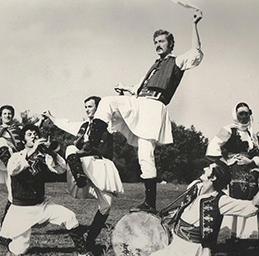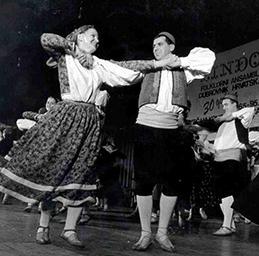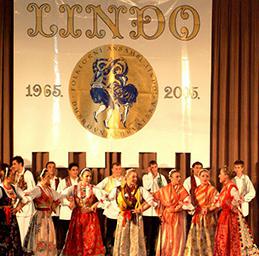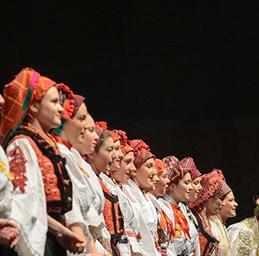THE HISTORY OF THE LINĐO FOLKLORE ENSEMBLE
The beginnings of organised amateur folklore activities in Dubrovnik were recorded in the second half of the 20th century, when in educational institutions, as a part of extracurricular physical education activities smaller folklore groups were being organised. Holders of such programmes were rare teachers with sharp sense of preservation and presentation of traditional folklore heritage.
 THE BEGINNINGS OF THE LINĐO ENSEMBLE
THE BEGINNINGS OF THE LINĐO ENSEMBLE  ENSEMBLE ANNIVERSARY CELEBRATIONS
ENSEMBLE ANNIVERSARY CELEBRATIONS  40TH ANNIVERSARY CELEBRATION OF THE LINĐO ENSEMBLE
40TH ANNIVERSARY CELEBRATION OF THE LINĐO ENSEMBLE  50TH ANNIVERSARY CELEBRATION OF THE LINĐO ENSEMBLE
50TH ANNIVERSARY CELEBRATION OF THE LINĐO ENSEMBLE Among them, we should mention Ms Milka Crnčević, a teacher who established and lead a folklore group in the Lapad Elementary School. Numerous sports associations, choirs, as well as folklore groups, which operated in secondary schools in the 1960s closely cooperated with the Dubrovnik Youth Committee and a garrison located in the Dubrovnik military barracks – Kasarna, in Gruž. For the purpose of improvement and advancement of the existing folklore programme, at the initiative of the president of the Municipal Committee of Youth Associations of Croatia (MC YAC), Ms Marija Beba Dujmović (née Napica), and the cooperation with the local Dubrovnik Youth Organisation, in 1963 a folk group was established which in the Pedagogic Grammar School gathered about ten girls. Director and an accordionist of this group was a Croatian conscript from the Dubrovnik barracks, Mr Marijan Hudek. The emerging folklore group included only female dancers, who danced both male and female dance sections. Shorter girls danced female dance sections and taller ones male dance sections. The established folklore group did not have adequate dance costumes, i.e. folk costumes, in which to dance, so for the purposes of their first public performances they borrowed improvised costumes from the theatre, with redesigned traditional elements. The girls who danced female sections wore white shirts – dresses, with aprons and belts, and the ones who danced male sections wore white shirts with waistcoats, long dark trousers, boots and caps. Dance rehearsals were held in the sports hall of the Pedagogic Grammar School. As a result of its activity, the folklore group had two public performances: the first one at the Pedagogic Grammar School and the second one in the military barracks, on the occasion of the International Labour Day, on the first of May. After serving his military service, Marijan Huđek had to leave Dubrovnik, so it was necessary to find a new director. Marijan Hudek and Luka Obradović, who were older military conscripts in charge of the garrison’s cultural programme, met a newly arrived conscript, Sulejman Muratović, and proposed him to the Youth Committee in 1964. As a student of economy in Zagreb, Sulejman Muratović danced in an amateur Lado Ensemble Folklore Group, and was later a cofounder of the Zagreb Koleda Folklore Ensemble. His dance experience and knowledge largely determined the future direction of this folklore group. The president of the MC YAC, Beba Napica, addressed responsible garrison officers and asked for permission to allow the conscript Muratović to function as a director of the folklore group. The request was approved and soon he started with the work.
Muratović asked for a rehearsal area, as well as an accordion player, and it was approved that dance rehearsals be held in the sports hall of the Pedagogic Grammar School, and for the accordionist they chosen Stijepo Granada, who was then employed at the Dubrovnik philharmonic orchestra. The audition was organised to which twenty-six girls applied, mostly from the Pedagogic Grammar School. The existing folklore group was thus reinforced and the conditions created for its further development. At the very beginning, the dance rehearsals were held once a week, and since they had no male dancers, Muratović arranged for the dancers to rehearse once a week with conscripts from the garrison. The cooperation with the Dubrovnik barracks resulted with travelling to Mostar to the garrisons’ festival – a competitive gathering of different folklore groups from military barracks. About ten girls, members of the folklore group, together with the soldiers, boarded a train – a popular "Ćiro", and headed to their first unofficial folklore performance outside of Dubrovnik. Interest in folklore, under management of Sulejman Muratović, suddenly grew in 1965, and more young people started to join. The first performance for friends and families was held in the Marin Držić Theatre.
The same year, at the initiative of the president of the MC YAC, Marija Beba Dujmović, and Stijepo Stražičić, the director of the Concert branch of Dubrovnik Summer Festival and the founder of the Marin Držić cultural club, the idea came about the establishment of the Youth Ensemble of Folk Dances and Songs. Stijepo Stražičić persistently worked on it, trying to acquire inclination from all important social organizations, in which he eventually succeeded by establishing the Founding Committee, which was supported by the Municipal Youth Committee. It was composed of the representatives of MC YAC, Marija Beba Dujmović, Frano Nalbani, Baldo Čupić, Henrieta (Mendi) Regjo from the Tourist Association, Stijepo Stražičić from the Summer Festival, Antun (Ćićo) Petričić from the Atlas Travel Agency and Nikša Sabljić from the Teachers School. The name of the Youth Ensemble of Folk Dances and Songs - "Linđo" was devised by Stijepo Stražičić in September 1965 on the occasion of a reception at the premises of a Workers Centre (Ivan Morđin Crni). Two months after the performance at the Marin Držić National Theatre, on 8 October 1965, the first public performance was organised at the Revelin fortress.
The folk costumes were borrowed for the occasion from the Koleda Folklore Ensemble from Zagreb, and the audience consisted of tourist employees and the interested public. After that, Linđo performed several times at the National Theatre, but also at the Workers Centre. The founding committee of the Ensemble of Folk Dances and Songs "Linđo" in 1965 brought the decision to keep the then director and choreographer, Sulejman Muratović, in Dubrovnik to lead the Ensemble, and to provide him with all conditions necessary for his life in Dubrovnik. After the process of foundation was completed, in October 1965 the Committee of the Ensemble of Folk Dances and Songs "Linđo”, was appointed, which was made of: Sulejman Muratović, as the director; Ante Kalmeta, the representative of cultural institutions; Antun (Ćićo) Petričić, the representative of Atlas; Stijepo Stražičić, the representative of the Dubrovnik Summer Festival, and Henrietta (Mendi) Regjo from the Tourist Association as the head of the Committee.
The Tourist Association, the Atlas Travel Agency, the Tourist Alliance and the Tourist Fund provided the funds for procurement of folk costumes and instruments. They thus acquired 43 female folk costumes and 37 male costumes from various regions of the former country, for example, Bačka folk costumes from Vojvodina, Sava-basin folk costumes from Croatia, Valpovo folk costumes from Croatia, Rugovo folk costumes from Kosovo, folk costumes from the Vardar Basin, and folk costumes from Mariovo from Macedonia. The membership increased to about thirty, and eight musicians from the City Orchestra have also joined. From the very beginning, the female dancers were divided into tall and short dancers, but they lacked male dancers, so they sought help from the garrison soldiers. In 1965, when it was established, the Ensemble held the first performance for foreign guests in the Jadran restaurant, and on 29 November 1965, on the occasion of the Republic Day, it performed in the Workers Centre. Dance rehearsals were held in the halls of the former Preparandija, the Luka Sorkočević Music School, the Grammar School, the building of Sloga in the Miho Pracat Street, in Revelin, the Gallery, and even in Lazareti, so that the problem of adequate premises and halls accompanied the Ensemble from the very beginnings. While the performers in the 1970s held their dance rehearsals in Revelin, younger pioneers and youth groups had rehearsals at the Dubrovnik Art Gallery (the premises were let for use in 1975) and in Lazareti. When in 1990 the Ensemble was assigned a hall in the former Ivo Čubelić printing shop, it seemed that the problems were solved. However, that facility was never granted for the Ensemble's use. The main performances for foreign visitors were held in the Revelin fortress, and the occasional ones in the Workers Centre and the National Theatre.
. After the Tourist Association saw the possibility of independent financing, from 1966 the Linđo ensemble operated completely independently as a citizens' association. It was probably then, or at the end of the 1960s, thanks to procurement of folk costumes from the other states and the empowerment of a respectable international programme with choreographies from the neighbouring states, the Ensemble of Folk Dances and Songs "Linđo" changed its name to the Ensemble of Folk Dances and Songs of the Yugoslav Nations "Linđo". Such change in the name was prompted by the desire to affirm the Ensemble as a unique folklore product that can sovereignly represent the rich traditional heritage of the various nations of Yugoslavia in Dubrovnik, the international cultural center of the country at the time, but also abroad. The Ensemble operated under this name until 1991, when it changed its name to the Linđo Folklore Ensemble, and focused its programme solely to traditional culture of the Republic of Croatia. The recognizable emblem of the Linđo Folklore Ensemble, which accompanied it from its very beginnings, presents a lijerica player and is a graphic design by Ivo Grbić, the noted Dubrovnik academic graphic artist. At the very beginning, the Society was managed by the Assembly with the Executive (Administrative) Committee, Monitoring Committee and the Artistic Board. The president of the Executive Board in the 1970s was Ante Božinović, the president of the Dubrovnik Municipal Assembly, who, owing to his position, but also his understanding of the Ensemble, significantly helped its development. The Artistic Board decided on the dance programme, procurement of folk costumes, membership, etc. The president of the Artistic Board in the 1970s was an ethnologist Božidar Kalmeta, director of the Dubrovnik museums, who, in cooperation with the member of the Artistic Board, Sulejman Muratović, created cultural policy of the Ensemble. In addition to the aforementioned, another ethnologist and dancer in the Ensemble - Dragan Elaković - was a member of the Artistic Board. The Executive (Administrative) Committee, in addition to other elected members from different organisations, always had one representative of the Linđo members from among dancers or musicians. Given that Linđo, particularly during the 1970s, achieved exceptional success, numerous social organizations wanted to acquire it for themselves and incorporate it into their business. Since Linđo, as a citizen’s association, kept close relations with the Youth Organisation, to whose initiative it emerged, the Statute of the Ensemble included the clause i.e., an article stating that if the Ensemble ceases to operate, all assets, including costumes, would become the property of the Youth Organisation. All necessary investments in the maintenance of the premises, costumes, instruments and employees, Linđo financed from its own revenues, but also from loans from social organizations, which it duly repaid.
For example, the company Hoteli Plat helped Linđo decorate the premises on the ground floor of the Dubrovnik Art Gallery, and in return, the members of Linđo performed every Wednesday in that hotel. The Ensemble reached its greatest success in the period from 1970 to 1985. Already in 1974, Linđo held 88 performances for more than 30.000 visitors, and in addition to regular performances on Mondays and Fridays, as well as performances at the Dubrovnik Summer Festival, it performed in many hotels in the City and the surrounding area (Hotel Plat, Hotel Croatia, etc.), including Jadrolinija ships "Dalmacija", "Jedinstvo" i "Istra", as well as the cruise ship of the Bergen Steamship Company. The usual performances in Revelin, on the terrace or inside the fortresses, could accommodate up to 500 visitors, but in the 1980s the number of visitors, thanks to tourist groups, could be significantly larger – up to 1500 visitors. In such cases, the dance performances were organized in the Sports Hall in Gospino polje. The membership grew each year, and in 1980 Linđo had more than 400 members, performing in two music groups and four dance groups. Furthermore, the same year Linđo had more than 30 choreographies in its repertoire, and owned 500 folk costumes and 50 instruments. The membership was divided into pioneers and youth groups, and performers. Directed by Sulejman Muratović, an experienced manager and a dancer, and following the trends of the Zagreb School of Folklore, but also accepting to a certain extent the choreographies of a somewhat different type, Linđo was "devoid of any baletisation, routine professionalisation and choreographical and scenery imitations", as noted by one newspaper critic. Its vivid performances gave an impression of a living and authentic traditional being. At the breakout of the Homeland War, Linđo continued with its operation, although many of its members went to the battlefields. Dance rehearsals were held regularly, and certain members – soldiers, occasionally joined. At that time, a series of performances were held for the members of the International Community observers at the Argentina Hotel. Especially prominent was a wartime performance at the Dubrovnik Summer Festival in 1991 at the premises of the Jadran restaurant. That performance, for security purposes, was not advertised, but had emotional and symbolic meaning for the then besieged City. Due to the lack of tourist performances, there was a shortage of funds necessary for normal functioning of the Ensemble. The help in those difficult circumstances, as well as during the following years, was provided by Atlantska plovidba, and later by the Atlas Travel Agency, the government of the City of Dubrovnik and the Dubrovnik-Neretva County. In 1998, the City of Dubrovnik took over the ownership of the Ensemble, including its financing. In 1999, the Ensemble became an institution under the name of Linđo Folklore Ensemble – Dubrovnik. Since its establishment, Linđo celebrated several anniversaries.
On the occasion of the ten-year anniversary in 1975, there were festive performances in Revelin and a festive dinner at the congress hall of the Libertas Hotel. 1980 marked 15-year anniversary and 1985 – the 20-year anniversary, celebrated by the performances in the Sports Hall in Gospino polje and in the Libertas Hotel (on this occasion, Zagreb TV produced a television programme dedicated to Linđo), In 1990, 25 years of existence was again marked by a performance in the Sports Hall, a ceremonial awarding of certificates of appreciation in the Dubrovnik President Hotel and a dinner at Gradska kavana. The thirtieth anniversary in 1995 was celebrated by a performance in the Sports Hall, and the thirty-fifth in 2000 by a performance in front of the cathedral. From then until 2015, the anniversaries were celebrated every five years, with an inevitable performance in the Sports Hall. The celebration of the fiftieth anniversary included a rich program that started on October 7 and ended on December 4, 2015. As part of the programme, a meeting was organised of the first generation of the Linđo Folklore Ensemble in the Jadran restaurant, as well as a meeting of the wartime generation 1991, on the occasion of which plaques were awarded to all members who, during the time of the Serbian aggression against Dubrovnik, in difficult wartime conditions and amid destruction, managed to preserve the spirit and culture of the Croatian nation. A memorial service was held in honour of the deceased members of the Ensemble in the Cathedral of the Assumption of the Blessed Virgin Mary.
Furthermore, the programme included the presentation of the documentary Balaj Linđo by Tonko Jović at the Marin Držić Theatre, a festive performance of all generations of the Linđo Folklore Ensemble in the Sports Hall in Gospino polje, a celebratory assembly at the Marin Držić Theatre and a celebratory dinner at the Lacroma Hotel. In cooperation with the Office for Dubrovnik's candidacy for the European Capital of Culture, an exhibition was held entitled ‘Homo u kolo – 50 godina djelovanja Folklornog ansambla Linđo’ (C’mon lets dance the Kolo! - Linđo, the Folk Dance and Music Ensemble: the first fifty years) by Ivica Kipre. On that occasion, a selection from the rich fund of folk costumes of the Linđo Folk Ensemble and numerous documents and photographs were presented. Today, Linđo has 400 members, divided into three preparatory groups, a performing group and a children's group Linđovo blago (Linđo's treasure). For occasional and anniversary performances, regular membership is joined by a veteran group. Since its founding until 2018, Linđo had more than 3000 members – dancers, singers and musicians. The Linđo Folklore Ensemble was and remains a symbol of the city of Dubrovnik and a meeting place for many generations of Dubrovnik residents, and a unique place where the traditional culture of Croatia is permanently nurtured and preserved in a special way.








